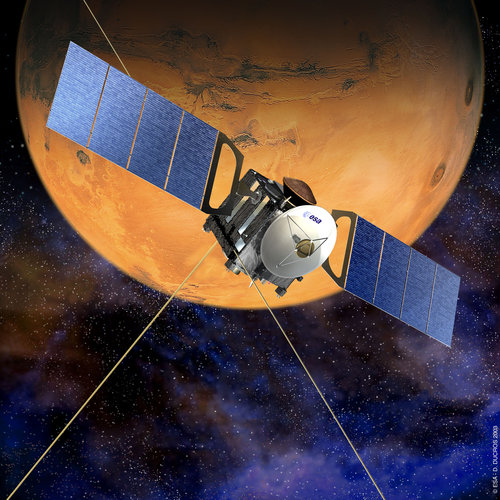
Copernical Team
Earth from Space: Alakol, the multicoloured lake
 Image:
Lake Alakol in eastern Kazakhstan is featured in this radar image captured by Copernicus Sentinel-1.
Image:
Lake Alakol in eastern Kazakhstan is featured in this radar image captured by Copernicus Sentinel-1. 5 Bitcoin Alternatives Worth Considering in 2025
 From being dismissed as internet magic money to becoming a household name, Bitcoin is now the poster child of cryptocurrency. However, Bitcoin isn't the only player in the game anymore. A number of other coins are stepping up, offering real use cases, better tech, and in some cases, more growth potential.
From being dismissed as internet magic money to becoming a household name, Bitcoin is now the poster child of cryptocurrency. However, Bitcoin isn't the only player in the game anymore. A number of other coins are stepping up, offering real use cases, better tech, and in some cases, more growth potential. SpaceX mega-rocket Starship 9 cleared for launch following earlier mission failures
 The Federal Aviation Administration has approved the launch of SpaceX's Starship 9 after two mission mishaps idled the program for months.
"The FAA conducted a comprehensive safety review of the SpaceX Starship Flight 8 mishap and determined that the company has satisfactorily addressed the causes of the mishap, and, therefore, the Starship vehicle can return to flight," the FAA said in
The Federal Aviation Administration has approved the launch of SpaceX's Starship 9 after two mission mishaps idled the program for months.
"The FAA conducted a comprehensive safety review of the SpaceX Starship Flight 8 mishap and determined that the company has satisfactorily addressed the causes of the mishap, and, therefore, the Starship vehicle can return to flight," the FAA said in NASA's Dragonfly mission sets sights on Titan's mysteries
This request seems a bit unusual, so we need to confirm that you're human. Please press and hold the button until it turns completely green. Thank you for your cooperation!
Press and hold the button
If you believe this is an error, please contact our support team.
185.132.36.159 : 711feb19-636d-405c-b9d5-40ca0b96
Mars Express updates software, potentially extending spacecraft lifetime

Mars Express mission operators at ESOC successfully sent a new software patch that would allow the spacecraft to operate in its third decade.
Media invitation: embark a tall ship for a dive into ocean science

On the morning of 4 June 2025, ESA offers media representatives the exclusive opportunity to step aboard the iconic Norwegian tall ship Statsraad Lehmkuhl, docked at Quai Amiral Infernet in Nice, France. This remarkable vessel arrives following ESA’s six-week Advanced Ocean Training Course, a transformative journey from Tromsø, Norway, where emerging researchers have been immersed in the world of ocean science.
ATLAS showcases secure software platform to enhance US military satellite operations
 ATLAS Space Operations and its subsidiary Freedom Space Technologies have successfully demonstrated the capabilities of their Freedom software platform for the U.S. Air Force Research Lab and the Defense Innovation Unit (DIU), validating a new model for secure and scalable satellite ground operations under the Hybrid Space Architecture initiative.
The demonstrations confirmed Freedom's abi
ATLAS Space Operations and its subsidiary Freedom Space Technologies have successfully demonstrated the capabilities of their Freedom software platform for the U.S. Air Force Research Lab and the Defense Innovation Unit (DIU), validating a new model for secure and scalable satellite ground operations under the Hybrid Space Architecture initiative.
The demonstrations confirmed Freedom's abi Tracing ancient cyanobacteria reveals early origins of circadian clocks
 To shed light on the evolutionary roots of the cyanobacterial circadian clock, a Japanese research team has traced the development of timekeeping proteins from ancient bacterial ancestors. Their study focused on the oscillatory behavior of KaiA, KaiB, and KaiC proteins, comparing the mechanisms in modern cyanobacteria to those of ancestral versions.
"Extant cyanobacteria utilize a circadia
To shed light on the evolutionary roots of the cyanobacterial circadian clock, a Japanese research team has traced the development of timekeeping proteins from ancient bacterial ancestors. Their study focused on the oscillatory behavior of KaiA, KaiB, and KaiC proteins, comparing the mechanisms in modern cyanobacteria to those of ancestral versions.
"Extant cyanobacteria utilize a circadia Do photons wear out? An astrophysicist explains light's ability to travel vast cosmic distances without losing energy
 My telescope, set up for astrophotography in my light-polluted San Diego backyard, was pointed at a galaxy unfathomably far from Earth. My wife, Cristina, walked up just as the first space photo streamed to my tablet. It sparkled on the screen in front of us.
"That's the Pinwheel galaxy," I said. The name is derived from its shape - albeit this pinwheel contains about a trillion stars.
My telescope, set up for astrophotography in my light-polluted San Diego backyard, was pointed at a galaxy unfathomably far from Earth. My wife, Cristina, walked up just as the first space photo streamed to my tablet. It sparkled on the screen in front of us.
"That's the Pinwheel galaxy," I said. The name is derived from its shape - albeit this pinwheel contains about a trillion stars. Navigate revisions to laws on hazardous chemicals in the EU

Changes to regulations and processes will introduce new restrictions on the use of hazardous chemicals in the EU. These could impact space programmes, the space sector and its supply chains – PFAS, chromates and the REACH revision take centre stage. Register for ESA’s free workshop on 17 June providing clarification on these changes and join us for a panel discussion.
